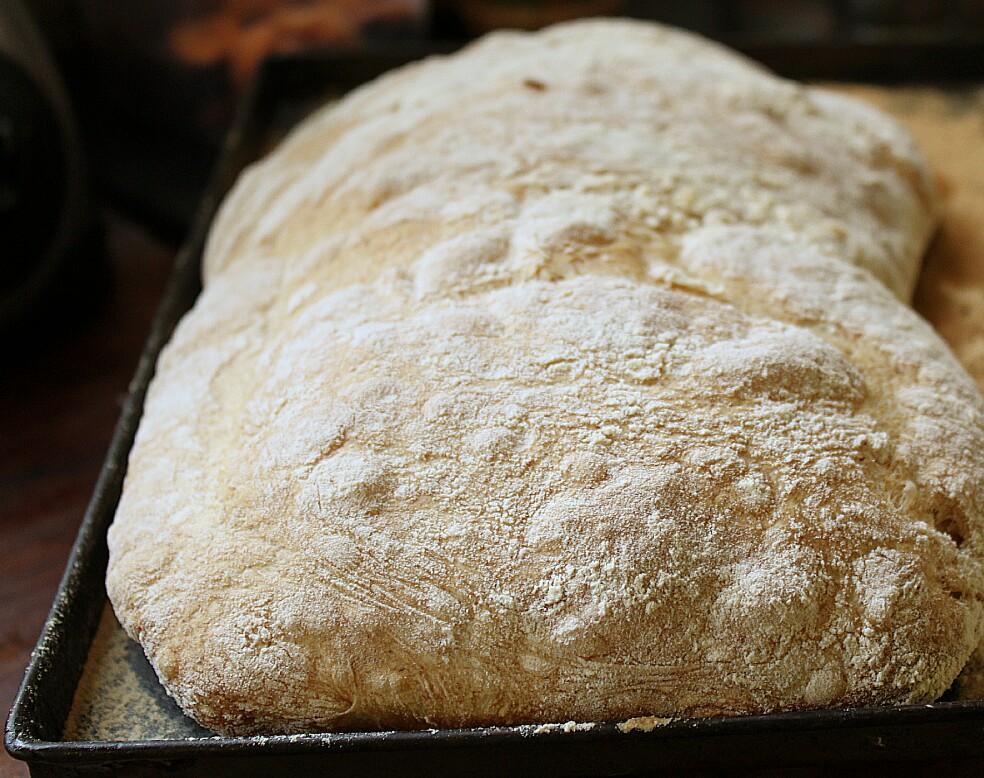Chris grows 60 hectares of wheat on the farm, which in a few weeks time will be harvested and sent to a miller-cum-baker up the road. I will watch with a wistful stare truckload upon truckload of wheat heading out the gate to be turned into flour and used in someone else’s bread. I know it’s business; I know it’s commercial farming. But I want some of that wheat! For my bread!

Soon after my arrival on the farm in February last year, I realized I had to find, or create, a recipe for quality bread. There was none, as far as I knew, in all of Zambia. I had been spoiled for choice living in America and Europe: I could buy fresh bread whenever I wanted that looked and tasted like it had come straight from the boulangerie. But I needed to find a recipe that would be simple and easy; that would work with basic ingredients; that was changeable if I couldn’t buy a type of flour; and that I could bake in a tiny gas oven with a dodgy temperature range (the Kenya Settlers’ Cookery Book’s Simple Test for Temperature notwithstanding).

Ciabatta, with its crusty outside and airy, chewy inside, has always been my bread of choice. Its rustic, country-table feel and look compliments our food and lifestyle. It was to this bread I turned when researching my ideal recipe, and lucky for me, it didn’t take long.
I found a foodie from New Zealand who, in 2010, posted a recipe for quick and easy ciabatta in her blog Pease Pudding (www.peasepudding.wordpress.com). She stated she’d been shown it by “the lovely Rafaella of Al Dente, who put the recipe together for her husband while on his sailing trips so that he could enjoy fresh bread on his journeys.”
All I can say is that this recipe changed our lives. Thank you Allison of Pease Pudding and thank you the lovely Rafaella. I just cannot imagine our table without a loaf.
Quick Easy Ciabatta
Ingredients:
- 500g/4 cups bread flour, or a strong all-purpose flour
- 450ml/2 cups water at room temperature
- 1⁄2 teaspoon sugar
- 1 1⁄2 teaspoon dry yeast
- 1 teaspoon salt
- 1 tablespoon olive oil
Method:
- Preheat oven to 200/400 degrees.
- In a large bowl sieve flour and combine with the sugar and yeast.
- Pour in the water, add the salt, and then ‘beat’ in the bowl with your hands for 5 minutes. The dough should be like a very thick pancake paste not a regular bread dough. To beat the dough, grab with your hand, stretch it up high, and then slap it down again. [This is when you can rid yourself of any frustrations or anger because the sound effects are just like a good slap.] This pushes air pockets into the dough to create the ciabatta texture. You will ‘feel’ when the dough is aerated and thus ready. [The consistency changes and the dough becomes more malleable.]
- Form a ball of dough in the bowl, and pour the olive oil over the top so it is covered and slides down the sides.
- Allow the dough to rise covered with plastic wrap for about 1 hour, or until it doubles in size.
- Pour the dough onto a well-floured work surface, without kneading any further, and [gently] fold over like an envelope length-ways to create the ciabatta shape.
- Lift dough onto a floured baking tray and bake for about 45 minutes, until golden, and when tapped, sounds hollow.
Note: This bread lasts a long time if kept refrigerated. To ensure you have a crunchy crust and soft interior a few days in, give the ciabatta 15 minutes in the oven at 180/350 degrees before serving. It will come out as though it’s just been baked. It also freezes really well.



15 Comments
Am definitely going to try it…our closest really good ciabatta is and hour and a half away in Kalk Bay at the Olympia. Remember the bakery? A bit far to go for fresh bread in the morning! Love your description of the wheat being grown on the farm xx
I remember that cool bakery very well, Hellie! We loved it. This bread is really easy, but know it’s all in the slapping. You need to ‘aerate’ it … xo
Nice for camping. Have you found a way to incorporate the farm wheat into yours? Your own stone grinder?
Hi Trudy … yes, this bread would be great for camping. Chris has tried hammermilling the wheat, but this method heats up the gluten and destroys its baking quality. We need to find a stone grinder, thus the search has begun. Thanks for your interest! Annabel
[…] Our much-loved ciabatta bread. […]
[…] jelly and camembert on homemade ciabatta is a favorite […]
[…] add a dash of lemon juice, a pinch of salt, and lots of cracked black pepper. I serve it on my homemade ciabatta bread, sprinkled with crispy bacon bits, atop a bed of salad. I make up the salad according to what is […]
[…] I served this lamb tagine for lunch on a recent balmy Sunday and paired it with an edible flower couscous, inspired by another of my favorite British chefs, Sarah Raven. It was a pairing that surpassed even my expectations, which was complemented by a selection of salads fresh from the garden, and my homemade Ciabatta bread. […]
[…] Neatly arrange pieces of goat cheese with the saved beetroot, leaves and pumpkin seeds on top of the salad. Spoon over the remaining dressing, and garnish with the echinacea petals and onion flowers. Serve with a ciabatta bread. […]
[…] a Thai Green Chicken Curry, a Thai Red Vegetable Curry, Jasmine coconut rice, freshly baked ciabatta bread with farm butter, and a homegrown garden salad with an Asian dressing. This was followed by a […]
[…] since I started serving homemade ciabatta bread to my Livingstone friends, they have urged me to teach them how to make it. Later, as I’ve […]
[…] Aubergine Baba Ganoush with Fresh Herbs, served with homemade ciabatta bread. […]
[…] well served hot. My preference was to serve it at room temperature, alongside hot chunks of fresh homemade ciabatta bread slathered in […]
Hello, Annabel! I have baked ciabatta according to your recipe several times! Easy, affordable and delicious in the end! Thanks for the recipe and detailed description! Greetings from Livingstone!
How lovely to hear from you, Natalia! Thank you for letting me know that you are enjoying baking the ciabatta. Yay! High praise from an expert cook! All the best to you, and I hope to see you again soon … Annabel 🙂
Comments are closed.